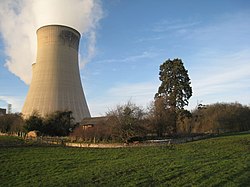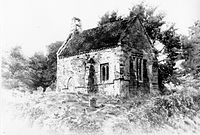West Burton, Nottinghamshire
| West Burton | |
| Nottinghamshire | |
|---|---|
 Low Farm, West Burton | |
| Location | |
| Grid reference: | SK800851 |
| Location: | 53°22’7"N, 0°48’56"W |
| Data | |
| Post town: | Retford |
| Postcode: | DN22 |
| Local Government | |
| Council: | Bassetlaw |
| Parliamentary constituency: |
Bassetlaw |
West Burton is a hamlet in Nottinghamshire, in the north-east of the county between the villages of Bole and Sturton le Steeple. The Saxon name "burh tun" suggests a fortified farmstead. The village is to the west of Gate Burton across the county border in Lincolnshire.
Contents
Oxbow lakes
West Burton was originally based around a now-deserted village, which went into terminal decline when the course of the River Trent altered at some time around 1797.[1] For many years afterwards the total recorded population was less than 60,[2] and the residential part of the parish had effectively been reduced to just one or two scattered farms and their neighbouring cottages – notably Grange Farm and High House Farm.
West Burton was originally on the side of the oxbow lake, once a huge, almost closed meander in the Trent known as the Burton Round. A similar oxbow lake known as Bole Round or 'No Mans Friend' was situated just adjacent to Bole. A flood in February 1792, cut through 'No Mans Friend' which was subsequently reported in the local press.
“A very singular event has lately taken place at Gainsborough, in Lincolnshire:- At Bole Ferry the Trent has formed itself a new channel, through which on Thursday se'nnight, two vessels passed abreast. Eighty or ninety acres of fine pasture land, the property of Sir E. Anderson, and Miss Hickman, are cut quite away from the Lincolnshire side of the river, and a complete island is formed between the late and present channel.” [3]
At Burton Round, the Trent took a circular sweep that a boatman might have thrown his hat on shore and after sailing two miles taken it up again.[4] The Burton Round is referred to in Shakespeare's[5] play Henry IV - Part 1
"Methinks my moiety, north from Burton here,
In quantity equals not one of yours:
See how this river comes me cranking in,
And cuts me from the best of all my land
A huge half-moon, a monstrous cantle out.
I'll have the current in this place damm'd up;
And here the smug and silver Trent shall run
In a new channel, fair and evenly;
It shall not wind with such a deep indent,
To rob me of so rich a bottom here.”
Church of St Helen
The ecclesiastical parish of West Burton was joined to the benefice of North Wheatley in 1884, even though these two adjacent places had no direct connection by road. The disused church of St Helen, founded in mediæval times and previously served by a perpetual curate, was finally demolished around 1886,[6]
The church at West Burton was given to Worksop Priory by Geoffrey de Malquinci at the end of the 12th century and was appropriated 5 June 1234, but no vicarage was endowed. After the dissolution of Worksop Priory under King Heny VIII, William Nevill became the impropriator, in 1545. He and his successors retained the advowson: the right to nominate the curate. West Burton was united with North and South Wheatley in 1884 and at a vestry meeting the next year it was decided to apply for a faculty to pull the church down in view of its disused and dilapidated state; which was granted on 7 January 1886.[6]
An annual harvest thanksgiving service was revived on the site in the 20th century, which continued for many years.[7]
The site is a Scheduled Ancient Monument.[8]
Stirling bomber crash
On the evening of 24 April 1944, Short Stirling Mk3 LK552 JF-C from No. 1654 Heavy Conversion Unit RAF Wigsley in Nottinghamshire took part in a night navigational exercise. The pilot was Pilot Officer Lee from No. 65 Course. At 11,000 feet and 0105 hours, nearing the end of the exercise, the port inner engine failed but the port outer engine was inadvertently shut down. With both port engines inoperative the pilot was unable to control the aircraft. All the crew baled out near the Cheese House in West Burton.[9]
West Burton Power Station
The quiet and largely agricultural character of the area underwent a total transformation in the years following February 1961, when the Central Electricity Generating Board received consent for the building of the first West Burton Power Station, at that time intended for completion in 1967.[10] This was constructed on land surrounding the original deserted hamlet, and in subsequent years its cooling towers have totally dominated the surrounding countryside.
The power station was the first 2000 MW station to be built in Britain and therefore attracted a large overseas interest at West Burton including the Shah of Iran, who visited accompanied by the Lord Lieutenant of Nottinghamshire
Low Farm was demolished in 1992 by National Power, it was the last remaining building in the close proximity of the old deserted village.
Outside links
| ("Wikimedia Commons" has material about West Burton, Nottinghamshire) |
References
- ↑ West Burton Deserted Village: [1], report by Nottinghamshire Community Archaeology, retrieved 28 December 2011
- ↑ A Vision of Britain: West Burton [2]
- ↑ Leicester Journal' for the Friday 3rd 1792
- ↑ The Rev J. Gurnhill in his "Monograph on the Gainsborough Parish Registers" 1890
- ↑ William Shakespeare, Henry IV, Pt.I., Act III, Sc. I
- ↑ 6.0 6.1 Train, K S S: 'Lists of the Clergy of North Nottinghamshire' (The Thoroton Society, 1959–60) page 28
- ↑ The Country Parish, Retford Rural Deanery magazine, September 1962 (West Burton)
- ↑ National Heritage List 29915: Site of the Church of St Helen (Scheduled ancient monument entry)
- ↑ Conversion Unit. Formed at Swinderby (UK) in May 1942: National Archives
- ↑ The Times newspaper, Tuesday, 21 February 1961; pg. 5

